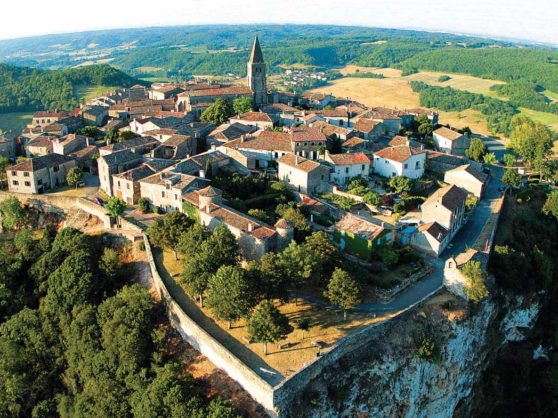
From the top of its rocky promontory overlooking the Vère valley, the fortress of Puycelsi offers today one of the most beautiful views of the region and in particular on the forest of Grésigne.
Puycelsi, named "fortress of the woods", classified among the "most beautiful villages of France" is also classified with Castelnau-de-Montmiral in 2018 in the prestigious rank of the Great Sites Occitanie, under the aegis of the destination Cordes-sur-ciel & medieval cities.
A little history...
In 1180, Abbot Pierre d'Aurillac sold the seigneury to the Count of Toulouse, Raymond V, interested in the strategic importance of the site. The Counts of Toulouse fortified the place and built a castle, which has now disappeared. Loyal to the Count of Toulouse, Puycelsi resisted twice to the Montfort during the Albigensian Crusade: to Simon de Monfort in 1211, then to his brother Guy in 1213, who were unable to seize the citadel. In 1229, the Treaty of Meaux, which marked the end of the Albigensian Crusade, stipulated that twenty-five cities that had resisted the victors were to be destroyed.
The dismantling of Puycelsi then began.
However, the village valiantly resisted other invaders: the Viscount de Montclar's routiers in 1363, 450 Englishmen during the Hundred Years War and even the Sieur de Payrol, who was defeated during the Wars of Religion.
To the discovery of Puycelsi
Behind more than 800 m of ramparts, Puycelsi shelters stone, wood and brick houses from the 14th or 15th centuries and the covered way which offers superb views on the surrounding landscapes. Entirely renovated, Puycelsi offers narrow streets and the charm of its half-timbered houses, surprisingly preserved since the Middle Ages.
You should also discover the church of Sainte Corneille and its astonishing blue ceiling decorated with acanthus leaves and scenes of the passion of Christ and whose sculpture of a pig at the entrance recalls an ancient legend.
During your walk, you can also discover the remains of the castle of the lords of Puycelsi, the old guard towers...
The Forest of Grésigne
Today Puycelsi is an obligatory passage before approaching the state forest of Grésigne with its 3000 ha of chestnut and oak trees, and its heritage trail, composed of several loops that leave and return to the village.
Also worth seeing is the conservatory of ancient fruit species which preserves the memory of the flora and the ecological diversity, or the old open-air iron mines of La Janade, witness to the industrial effervescence of the 19th century.
The legend of the "French Pigs
At the entrance of the Sainte Corneille church, a sculpture reminds us of an ancient legend...
The English could not believe it. After weeks of siege during the 100 years war, in 1386, the defenders of the stronghold of Puycelsi let a fat pig walk on the ramparts. Legend has it that the English turned their backs on it. What they didn't know was that the wife of the local lord, who was defending the place, had only one pig, repainted each day with a different color and then mauled with a sword to make it look as if it had been slaughtered in order to have a feast. ....
Pays Bastides and Vignoble du Gaillac Tourist Office
Tourist information office of Puycelsi
Conservatory orchard - Le Roc
81140 Puycelsi
https://www.tourisme-vignoble-bastides.com/village-fortifie-puycelsi
Translated with www.DeepL.com/Translator
(free version)



